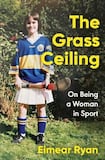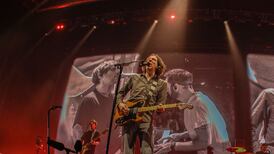
I remember the first time I was shown that my participation in sport meant less than that of my male counterparts. It was an evening like any other one I had spent on my local GAA pitch. I was never particularly talented at sport but some of my favourite memories were formed on that grass. Winning championships at various age levels and learning what it means to be a part of something, events that you still talk about with friends no matter how much time passes.
That evening, multi-coloured cones littered the grass and there was that familiar nervous anticipation of knowing you were about to be put through your paces. Suddenly, the dots of red and blue and yellow that marked our running path started disappearing. The wide patterns that our coaches had laid out for us were reduced in size as our half of the pitch suddenly became a third. There were confused glances as our male classmates ran by us, taking up the space we had just occupied.
“The lads have a match at the weekend so they need more of the pitch,” we were told. We had a match too but there was an unspoken acceptance among those around us that it mattered less. We mattered less.
It’s in these moments that the glow you get from playing sport and being surrounded by people who share the same mission starts to dim a little. It bleeds into other aspects of your life and you start to second-guess yourself and the world around you. It’s this push and pull between something you love but that doesn’t necessarily always love you back that Eimear Ryan gets so right in The Grass Ceiling.
An Irish doctor on why she believes autism, ADHD and depression are being overdiagnosed
Ireland’s remote islands: Only 29 apply for €84,000 grant aimed at attracting residents
Excuse My French restaurant review: An experience simply unlike anything else in Dublin
10 of the best new shows to watch in April: including Netflix medical drama and two AppleTV+ releases
Reading this book felt like letting out a breath I didn’t know I had been holding in. Not only was it the first time that I had read someone accurately portray all the confusion I had felt growing up, not understanding why my passion was different to others, it was also the first time I started to understand properly how that had affected other aspects of my life. How sport had both given me a voice and sought to take it away. It had made me appreciate my body and what it could do and also made me incredibly aware of how it looked in baggy jerseys that weren’t designed for my frame.
However, that’s not the only reason it made my chest relax and it would be wrong to define this simply as a book about a woman’s experience in sport. The themes are universal for anyone who has ever kicked a point, pucked a ball or stepped into any sporting arena. It burns with a passion that we rarely see women given the opportunity to write about. It charts the legacy of Ryan, her family and her home but also that of the wider GAA ecosystem. It’s a love letter as much as it is a diatribe against the idea that sport isn’t for women.
It’s this that makes the book special. As Ryan talks about her local community and the passion it had for club and county GAA, it’s easy to relate it to your own locality and that sense of pride whenever you see your colours flying. An early chapter is dedicated to her grandfather Séamus Ó Riain, a former GAA president, whom she credits as “the lightning rod” for her family’s love for the GAA which is a beautiful tribute to what it means to be part of something. When she describes catching his eye in Croke Park after playing a Cumann na mBunscoil exhibition match at halftime during the All-Ireland final in 1997 and seeing the glint of pride in his eye, it’s a reminder that it’s not so much the moments but the people we share them with that matter.
It also serves as a history lesson to remember those who got us this far. Say the name Cáit Ní Dhonnchadha in GAA circles and you might get some blank looks. A young activist, she was responsible for founding the Camógie Association in 1904 with her brother Tadhg and Máire Ní Chinnéide. At the time, the GAA was only for men and boys and they wanted to give women and girls the opportunity to play. She saw sport as a means of liberation for Irish women yet she and her co-founders are barely known.
“You get to think about your body in terms of what it can do, rather than how it looks. You become more engine than ornament. Camogie is the only context in which I have ever been praised for aggression. It teaches you to be commanding, to take your ground. To assert, rather than mitigate, your physical presence.”
This passage immediately brought me back to that day where my physical presence on a pitch was seen as an annoyance rather than being where it belonged. I’ve spent the past 15 years railing against that idea and using sport and my voice as the vehicle to do it. I’m glad that there’s now a book that women and girls can read that not only feeds their passion but tells them that their story can be about injuries and county finals and spending hours practising the game that you love and not just people telling you that you don’t belong there.
Kathleen McNamee is a journalist with On The Ball











